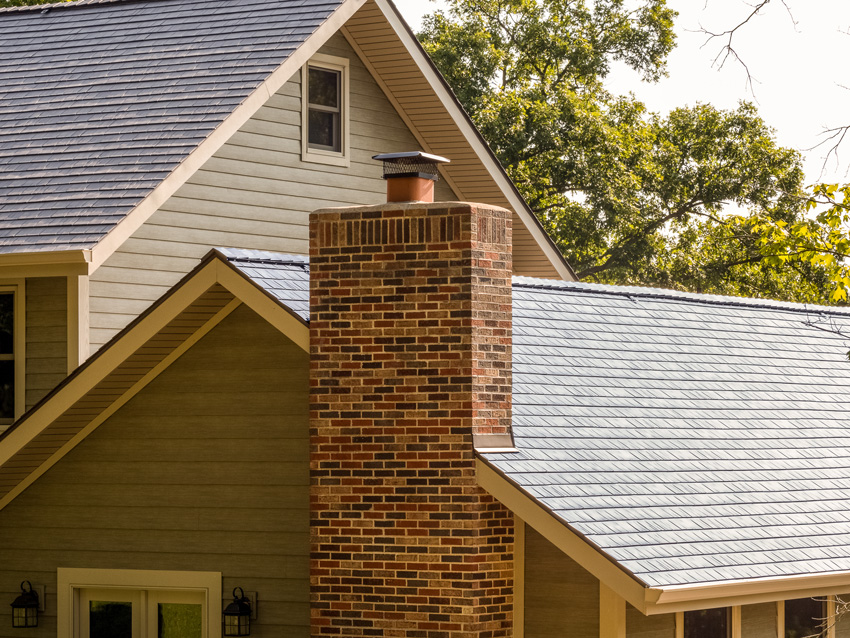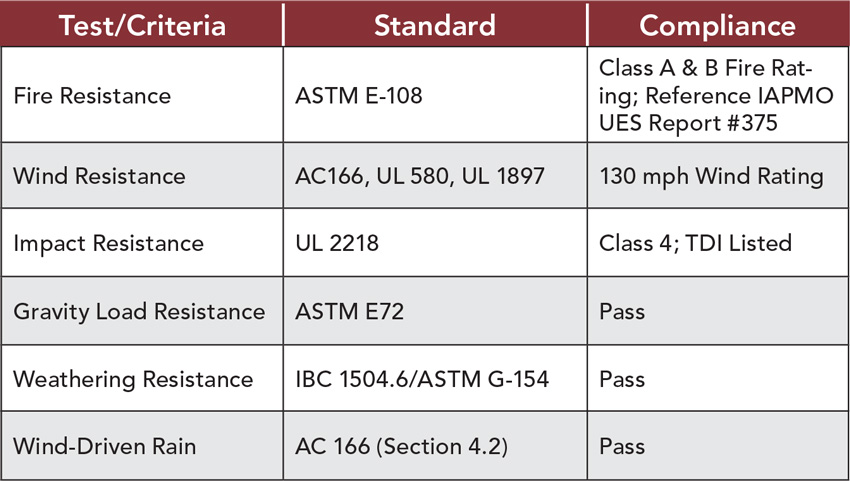Metal Roofing with the Appearance of Traditional Materials
Green Building Contributions of Traditional Appearance Metal Roofing
The U.S. Green Building Council has developed the well-known LEED rating system to recognize and certify buildings that can be considered to be green or sustainable. The current iteration of this popular system is LEED v4, which applies to a range of building types. Metal roofing can be used to help contribute to earning LEED credits and ultimately certification at the Certified, Silver, Gold, or Platinum levels in several ways described as follows.
Sustainable Sites (SS): One of the concerns of an urban environment is the proliferation of dark-colored roofing and ground surfaces that are known to absorb sunlight and radiate it back as heat. Walking across a paved parking lot on a sunny summer day is ample evidence of how well this phenomenon works, especially if you have thin-soled shoes or are walking barefoot. The same thing happens on a roof surface that absorbs sunlight rather than reflects it back. Get enough dark, heat-radiating surfaces together, and an urban heat island is created, which can raise the surrounding air temperature by as much as 5 degrees Fahrenheit.
Depending on the color and reflectance properties of any roofing material, it will absorb and reflect varying amounts of solar radiation. The way to measure that variation between materials is based on ASTM standards E903 and E892, which are used to determine the solar reflectance (SR) of materials. The test results are expressed as the fraction of solar energy that is reflected back on a scale of 0 to 1. Black paint, for example, has an SR of 0 (no reflectance, all absorption), and bright white titanium paint has an SR of 1 (highest reflectance). Applying this principle directly to green buildings, the solar reflectance index (SRI) has been developed as a measure of the ability of a constructed surface, particularly roofs, to stay cool in the sun. It relies on both an initial SR value as well as a thermal emittance value being determined for a material or product. Using ASTM E1980 and values from the Cool Roof Rating Council Standard (CRRC-1), an SRI of between 0 (common black surface) and 100 (common white reflective surface) can be determined. The higher the SRI, the higher the amount of solar radiation that is reflected and thermal radiation minimized, thus creating a comparatively cool surface.

The ability of metal roofing to achieve a high solar reflectance index (SRI) rating is part of its sustainability attributes that can contribute to green building design certification.
Metal roofing of all types can be readily finished to achieve high SRI values, which means they minimize heat creation and reduce urban heat islands. Lower outdoor air temperatures help make outdoor spaces more inviting, particularly for restaurant, entertainment, and hospitality settings. In the Sustainable Sites category of LEED v4, Heat Island Reduction can be selected as a credit to receive either one or two points toward certification. This credit relies on both roof and non-roof strategies and looks for calculations of solar SR and demonstrated SRI levels on specified products such as metal roofing. In order to earn points toward certification, a low-slope roof (2:12 or less), needs to demonstrate a manufacture SRI of 82 with a 3-year-aged SRI of 64. For a steep-sloped roof (greater than 2:12) the initial manufactured SRI needs to be at least 39 with a 3-year-aged SRI of 32. Recognizing all of this, many manufacturers have tested their metal roofing products and published the SRI results, allowing design professionals to make informed decisions and specify roofing products that meet the LEED criteria.
Energy and Atmosphere (EA): Hotter outdoor air temperatures not only make the surrounding outdoor spaces less comfortable to be in, but they also impact the energy requirements for buildings that need to generate more air-conditioning to keep them cool. So, specifying a “cool roof,” as just described, can also have a direct impact on the building’s energy use and interior environment. Further, a metal roofing system with a proper slope has often been used as an ideal base to support solar panels. Either of these factors can be used to help model reduced energy use in the building or to contribute to the design of a successful onsite renewable energy system.
Materials and Resources (MR): A prerequisite for any LEED building is to reduce the amount of construction and demolition waste by recycling, recovering, or reusing building materials. Since metal roofing products are shop-fabricated, there is very little waste to begin with. Any excess or scrap steel is readily and easily recyclable at the factory. It is also quite common to find that metal roofing contains a substantial percentage of recycled content.
Looking to the bigger picture, LEED v4 recognizes efforts to address the impacts of materials over their full life cycle. Toward that end, a life-cycle assessment (LCA) protocol is used to support certification points for this MR credit. Additionally, an environmental product declaration (EPD) based on the LCA and industry-wide product category rules help substantiate the green qualifications of metal roofing products. By using this information, where available, the environmental impacts of metal roofing can be determined from the extraction of raw materials through manufacturing and shipping (cradle to gate). The fact that steel products of all types contain a significant percentage of recycled material and can be again recycled at the end of the service life of the building contributes in producing very favorable LCA results (cradle to grave or cradle to cradle).
Specifying Traditional Appearance Metal Roofing
When specifying metal roofing, particularly those that have the appearance of traditional materials, we have seen that there are numerous choices and options to choose from. Coordination with manufacturers during the design phases of a project will help gain insight for project specific details, cost drivers, installation nuances, and the latest finish options. In a standard CSI or Master Spec format, the usual locations to include this specification is in Section 07.31.16: Metal Shingles (for slate shingle or wood shake appearance) or Section 07.32.19: Metal Roof Tiles (for clay tile appearance) or Section 07.41.13: Metal Roof Panels (general). Some of the relevant items to address in a standard three-part specification format are highlighted as follows.
Part 1: General
The scope of specification work can include all preparation work, substrate review, product choices, and final installation. In terms of specifying performance, the following testing standards can be referenced:

Submittals for metal roofing products should include the usual manufacturer’s data and information for all products used, plus samples or color and texture data to confirm that the correct appearance is being achieved.
Quality assurance is clearly an important part of any field installed system and the same is true here. It begins with the use of trained installers with a prescribed minimum number of years of experience. Evidence of such qualifications can be requested as a submittal, but it is important that the people actually in the field are the ones with the qualifications and experience needed. On-site protection of products should be carried out according to the manufacturer’s instructions and recommendations.
Part 2: Products
All of the relevant metal roofing products used in the building should be called out and specified. If different metal roofing products are used, then they should be identified by type in the specifications, and the locations of the different types need to be clearly called out in either the drawings or specifications. The details of the specified products can include:
- Specific type, size, and shape of the metal roofing product(s).
- Specific performance criteria for weight restrictions, wind resistance, impact resistance, and fire classification.
- Specific color and texture or pattern. Manufacturers’ literature should be consulted for this as with any finished product.
- Indication of the minimum required SRI of the product for solar reflectance.
In addition, all trim, accessories, fasteners, flashing, and related items need to be called out in the specifications based on compatibility with the metal roofing. In some cases, a waterproof underlayment material may be appropriate based on the roofing design. If so, that material should be specified along with the specific locations where it is required and the restrictions (if any) of its installation (i.e., temperature, dryness of substrate, etc.)
Part 3: Execution
As with any site installed product, the installation requires multiple steps which need to be clearly articulated in the specification in order to achieve the best results.
- Examination and preparation: The importance of this step should always be stressed. In addition to the architect, the installer should review and examine the substrate for conditions affecting the performance of the roofing. Any issues will need to be corrected if they are found to be out of compliance with the requirements of the specifications. All surface defects must be repaired using appropriate materials. Ultimately, the goal is to provide a substrate surface that has been prepared to an acceptable level, is clean of all contaminants, and free of any debris.
- Attachment: Metal shingles, shakes, and tiles are commonly nailed in place according to manufacturers’ instructions and directions. Those should be consulted to assure that the system is installed to meet the wind resistance and other conditions for a successful attachment.
- Protection: Once applied, the roofing surface should be protected during any remaining construction work, including final mechanical or electrical trimming, painting of adjacent surfaces, or any punch list work.
- Cleaning: Upon completion, the metal roofing should be cleaned of any construction or miscellaneous dirt, debris, etc. Painted metal roofing is a maintenance-free product that requires little continuing care beyond cleaning of any unusual buildup. Stone-coated metal will require some periodic cleaning and maintenance as recommended by the manufacturer.
When specified and installed correctly, the finished roof will provide the desired traditional look and long-term performance characteristics that are intended.
Conclusion
Metal roofing is no longer limited to corrugated or standing-seam profile panels. Instead, all of the appealing visual, green, and sustainable performance benefits of metal roofing are also available in products that have the appearance of traditional roofing materials such as clay tile, slate shingles, or wooden shakes. These choices and options not only contribute to great design, easier construction, and low maintenance, but they also bring green and sustainable qualities to the buildings on which they are installed. As Dale Walton, manager of residential product marketing at CertainTeed Roofing, sums it up, “Very few products today can live up to their hype…Metal lets its everlasting qualities speak for itself.”
End Notes
1“Sound Emission of Metal Roofing.” ATAS International. Web. 2 May 2018.
2“Noise Sources and Their Effects.” Purdue University. February 2000. Web. 2 May 2018.
Peter J. Arsenault, FAIA, NCARB, LEED AP, is a nationally known architect, consultant, continuing education presenter, and prolific author advancing building performance through better design. www.pjaarch.com www.linkedin.com/in/pjaarch

|
Founded in 1904 as General Roofing Manufacturing Company, CertainTeed is a leading North American brand of exterior and interior building products, including roofing, siding, fence, decking, railing, trim, insulation, drywall, and ceilings. www.certainteed.com |









